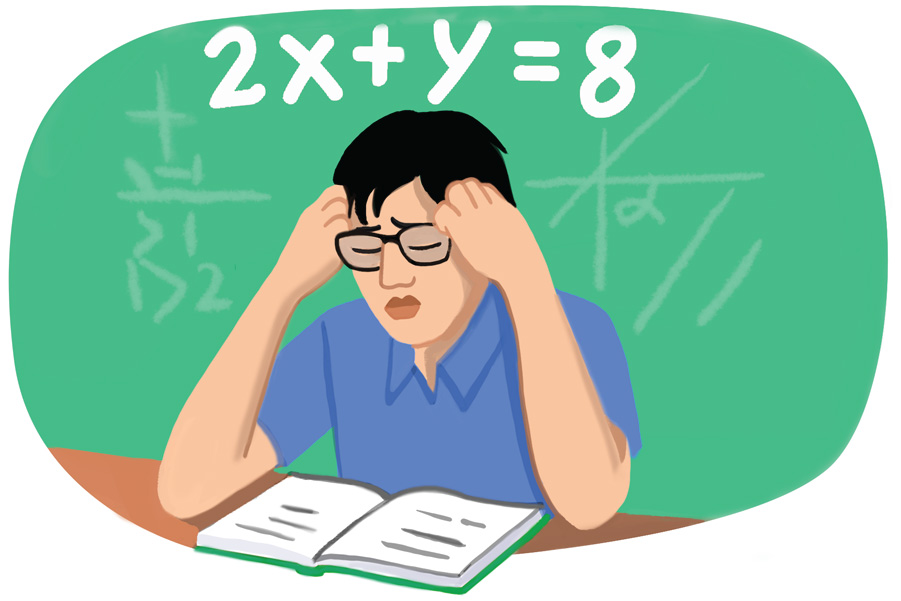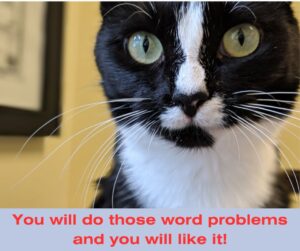You Want Me to Teach WHAT?

Hang in there!
by Linda Ramirez
Why math?
“You want me to teach what? Math? But I am an English language teacher. How dare you!”
These were the thoughts I had when I went into momentary shock after accepting an offer to teach adult international English language (EL) students in the Adult Education Department of a state community college in Massachusetts. Upon hire, I quickly learned that I would be expected to teach English language reading, writing, grammar, listening, and speaking in addition to cultural diversity, inclusion, American history, social science, community civics, and math. “Yes, of course,” I thought, “but, MATH?”
I began to rack my brain, thinking about the classes I had taken while recently completing my graduate school teaching certificate for English language teaching. None of my professors ever mentioned teaching math as part of an EL teacher’s job. The state must be mistaken, I thought.
But the state was right. According to the National Center for Education Statistics (NCES), 10.3 percent of all public-school students are EL students, a percentage that continues to increase. Furthermore, as recently reported by the Institute of Education Sciences, according to the National Reporting System for Adult Education, in the program year 2021-22, nationally, free or low-cost adult education programs enrolled about 900,000 students, with nearly 50 percent in English language acquisition or integrated English literacy and civics education programs. These EL students in public schools or adult education programs are required to meet the academic content and achievement standards expected of all students. And that includes math.
The data convinced me—EL teachers need to include math in their lessons. That meant I had to rethink my job as an EL teacher, whether it was creating lessons on solving math word problems, following instructions, or understanding and using mathematical vocabulary correctly, all of which are closely related to language acquisition.
OK, but why ME?
The problem was that I had long-standing math insecurities of my own. When I realized my mathematical responsibilities to my EL students, my old fears about math began to re-emerge from the recesses of my mind. They were like dark shadows taking the forms of anxiety blobs exploding inside of me.

Math was not my best subject when I was a young student. I liked reading and writing, but I always needed to give math extra time and attention. With extensive studying in middle school and midway through high school, I was able to complete algebra 1, algebra 2 and geometry classes. Therefore, when I was approaching my junior year in high school, I assumed I had paid my math dues and I could finally relax with math studies. The school district thought otherwise. I was placed in a trigonometry class for my junior year of high school. I had no choice in the matter.
Without any recourse to choose a different type of math class, I decided I would dedicate more study time than usual to accomplish my trigonometry study goals. Unfortunately, my efforts were unrewarded. No matter how much I paid attention to the math teacher’s daily lessons and time spent trying to decipher the math homework of five to eight assigned problems, I could not understand trigonometry.
Soon, I found myself staring more at the math classroom walls, which the math teacher had covered with numerous cherry-pink colored posters of cats and kittens in various cuddly, submissive feline poses. As the school year progressed and the trigonometry problems became more complex, I increased my attention on the cherry-pink cat posters. After a while, the math teacher started sounding like a screeching cat to me as she stood in front of her desk meowing different trigonometry problems in her loud high-pitched voice. She never wrote just one problem on the board. It was always a turbulent sea of five or more sample problems. She never walked around the classroom to help us individually. When she wrote the correct answer on the board (which I never could solve) I just stared in despair at the cat posters. Eventually, the cat posters made me feel nauseous. Don’t get me wrong, I love cats. But I had just developed a strong negative association between math class and those posters.
I realized I had to make a drastic request. The math teacher had class office hours for students on Wednesdays after school. After courageously admitting that I was having difficulty with the class, I privately asked her if I could come for extra help with trigonometry problems. At my request, she pursed her lips and looked at me through her thick glasses like I was an ugly-looking bug under a microscope. She did not ask me any questions as to why I was having learning difficulties. Instead, she quickly sneered, “Fine!” and then reminded me that I would be sharing the classroom with detention students. That was because her math classroom was also the room for after-school detention on Wednesdays. At that time, detention was issued as punishment time for days or a week at a time in rotating classrooms with rotating after-school teachers.

I attended two Wednesday after-school sessions in the detention/math classroom amidst detention students who threw paper airplanes at the cat posters while the math teacher read a book. On both occasions, I shyly approached the math teacher’s desk to tell her I needed help understanding the weekly trigonometry problems. And on both occasions, the math teacher curtly reiterated the same math problem to me that she had recited in class while she pointed to a few flimsy diagrams in my math book. “I went over these already in class,” she meowed, “so go back to your desk and try to solve them.” She returned to reading her book.
Disappointed, I slowly walked back to my desk. Then, I felt the sharp edge of something hit the back of my head and then my back. The detention students had become bored with shooting paper airplanes at the cat posters. Now, they were shooting their weapons of despair at me. I hated that classroom. I hated the pink posters. And I definitely HATED math!
After that, I did not return to the math teacher’s Wednesday after-school classroom. Instead, I kept my head down in class. I stopped trying to participate. I stopped talking to my classmates. I just painfully plodded through her class until I completely failed trigonometry by the end of the school year. The school district placed me in a ‘history of math’ class for my senior year so that I could graduate from high school on time. I had no choice in the matter. The only choice I did have was to never take another math class again—and I never did.
In college, I was only required to take one math class. I chose the history of math because I knew it would not involve any math equations, math formulas, or my math anxiety. After that, I did not take any math training again until I started working as an EL teacher and was required to take SABES trainings for professional development (PD). Thankfully, I have a department supervisor that encourages the EL teachers to take PD for math to build the EL curriculum. It has only been through SABES math PD that my math fears and insecurities began to slowly diminish.
Worth the wait (time)
Recently, I took a SABES math training called, Creating Your Math Classroom Culture, in which the concept of “wait-time” was introduced. I had never heard that term before taking this training. It was mesmerizing for me as we, the participants, watched a video about a math teacher utilizing wait-time in her math class, whereby she gave a deliberate 10-second pause after asking for a solution to a math problem to allow students time to process the question. Then, she gave a second deliberate pause of one to two minutes to allow students to give responses to the question. Next, she allowed students approximately 10 to 15 minutes to discuss with classmate partners how the problem should be solved. Finally, the teacher allowed another 10 to 15-minute period for students to debate and demonstrate for the class how the math problem needed to be solved. Some students gave wrong answers while others gave correct answers but it did not matter. The wait-time and processing time allowed all the students to understand how to calculate the correct answer and understand the mathematical process.
Most intriguing for me was noticing how none of the students in the video appeared nervous or fearful of the math problems or the math class. Contrary to my personal experiences with math classes, the students in this video were smiling and laughing with each other and the teacher while they were given wait-time to calculate a math problem. It was as if they were enjoying the discovery process more than the need to find the correct answer.
I was so intrigued by this concept of wait-time that I began to question my own teaching methods. I asked myself if I had been allowing enough wait-time for students in my class to practice English pronunciation, listening comprehension, and reading comprehension as well as math.
At first, it felt safe for me to start using wait-time for English reading comprehension in my EL classes following the SABES training. Traditionally, when introducing a new piece of reading to students, I ask each alternating student to read aloud one paragraph. In this way, I, as the teacher, can scaffold the student’s topic comprehension in addition to English fluency, accuracy, expression, rhythm, and pronunciation. Normally, if a student had difficulty pronouncing a word, I would automatically act as the super-hero teacher to save the student from any embarrassment. I would immediately give any struggling student the correct pronunciation. But now I started giving students five to ten seconds of wait-time. I listened to each student struggle to pronounce an unfamiliar word several times. To my surprise, most students eventually discovered, on their own, the correct pronunciation of new words when I allowed them wait-time.
More surprisingly, I discovered that when I gave wait-time to a reading student for word pronunciation, other students became frustrated by the silence and interrupted the wait-time by offering their version of the correct pronunciation. Shamefully, I realized that students had been learning this practice from me. They did not see me as the super-hero teacher saving students from embarrassment. Instead, I had been teaching students the artless act of impatience.
Ultimately, I had to start reminding impatient students that we needed to give the reading student time to think about word pronunciation. We established that students could offer their pronunciation advice only if the reading student asked for help. As the weeks progressed, my students soon became more comfortable with wait-time and silence in my class. When I asked them a reading comprehension question and was met with silence, I asked them the question again. Their growing responses to me became, “Give me a minute to process,” or “I’m not ready,” or “I need time to think.”
Now that I’ve successfully experimented with wait-time during reading comprehension activities, I feel more confident about applying this technique to math teaching. In a way, trying this new approach in language class gave me the wait-time I needed to build my confidence for teaching math. Now, I am looking forward to seeing how wait-time will continue to benefit my students and me.
Our special guest blogger, Linda Ramirez, is an English language teacher who enjoys encouraging her students to gain self-confidence through developing reading, writing, speaking, listening and math skills that will allow them to embrace their future opportunities. When she is not teaching, she enjoys doing container gardening, reading, cooking new vegetarian recipes for her husband and family, and visiting farmers’ markets with friends. When she has extra time, she enjoys volunteering at her church, Union Church in Boston, MA, in their Food Forest community garden ministry, a serving partner with the Boston Food Forest Coalition that works to improve local food production, public edible parks as well as socially and ecologically thriving gardens for the community. Sometimes in quiet moments, she wonders if she would have been an agricultural and food scientist as well as a teacher today if a teacher had encouraged her in math studies when she was young.
